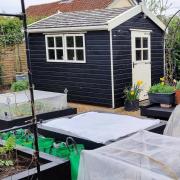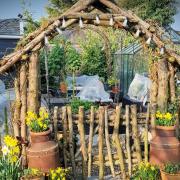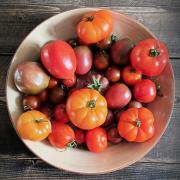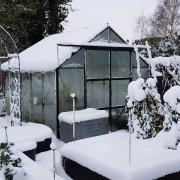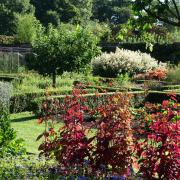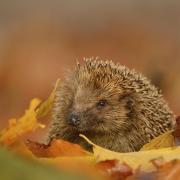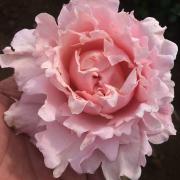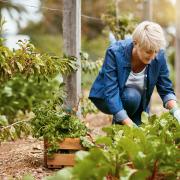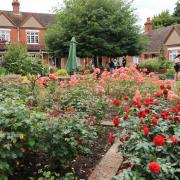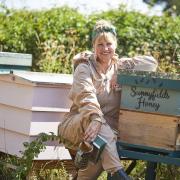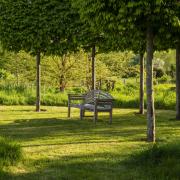Julianne Fernandez has transformed a former agricultural site in the Waveney Valley into a garden of spectacular borders, a wildflower meadow and year-round colour and interest

Julianne Fernandez has just spotted a rampant sow thistle in a clump of vivid blue salvia. “Weeds! My worst dread with the opening coming up,” she says. “I’m going to have to do a bit of tidying in here.”
I’m on a sneak preview before Julianne opens her inspirational garden in the Waveney Valley for the National Gardens Scheme. It may be a cliché to talk about wow factors but this garden invites it, dare I say, in spades. It’s all the more impressive when you consider this was all part of a farmyard less than ten years ago, before Julianne worked her planting magic on it.
“When we bought it there was literally nothing apart from a very few young trees. No hedges, no garden, nothing,” she stresses. “So this is created from nothing.”
Forget traditional herbaceous borders and think swathes of bright perennials with silky grasses flowing through and a wildflower meadow at the heart of it. The inspiration, says Julianne, comes from the profusion and abundance of planting seen at Great Dixter in East Sussex created by gardening writer, the late Christopher Lloyd.

Julianne’s planting schemes are original and distinctive, a huge endorsement for her switch of career from insurance broking in the City of London, a move that saw her gain a distinction from the Inchbald School of Garden Design before launching Chasing Arcadia Garden Design.
She is now a garden and landscape designer of some note, taking a Gold Medal and ‘Best Fantasy Garden’ at Japan’s Huis Ten Bosch International Garden World Cup in 2019 and, this year, winning a place at the BBC Gardeners World Live at Birmingham’s NEC. Sadly her ‘Sea Garden’ design, with Suffolk-based Teasels Landscapes, can be viewed only virtually due to Covid but, Julianne beams, “we’re doing it next year for real”.
Julianne grew up in Suffolk, having moved from Tunbridge Wells to Boxford at the age of eight due to her father’s job, and now lives with her husband in a converted barn not far from Beccles – “so most of my life has been spent in East Anglia”. She has a real affinity with the landscape and aims to create “an unmistakeable sense of place” whatever the size of garden. Her own garden, with its wonderful views and vistas, reveals Julianne’s delight in shapes, textures and forms, giving her vast borders lasting architectural appeal.
“It’s not just about colour,” she explains. “In fact, for most gardens, what’s more important is the shape and contrast in form and movement because that’s there most of the time, whereas the colours come and go.”

Even so, she displays her confidence with colour in her original ‘hot’ border where red and yellow planting has evolved into a scheme with blue eryngium, echinops and borage, complementing the backdrop of the smoke bush Cotinus ‘Flame’ and the whorls of the yellow Turkish sage Phlomis russeliana.
A pair of Adirondack chairs in a sunken circular area provides an all-season focal point before the next surge of planting, where the intensely blue Salvia nemerosa ‘Ostfriesland’ and a mass of blue and burgundy scabious are punctuated by a pair of sturdy obelisks and the vivid pink rose campion Lychnis coronaria has self-seeded into great vivid clumps.
“A bit of a thug but very, very spectacular,” says Julianne fondly. She likes to create an element of surprise as with the large and exotic Tetrapanax papyrifer which, she points out “you wouldn’t normally expect to find in a traditional English garden”.
Ahead of us is an extraordinary wave of planting - 30 metres long and up to five metres wide – which Julianne calls her ghost border. It starts with a great throng of the globe thistle Echinops sphaerocephalus ‘Arctic Glow’ with more phlomis and the tall mullein Verbascum chaixii ‘Album’.

The flow of planting reflects the natural feel of the wildflower meadow opposite and, further on, frothy green Alchemilla mollis with ornamental grasses Stipa tenuissima and Calamagrostis x acutiflora ‘Overdam’ complement creamy Hemerocallis ‘Gentle Shepherd’, white monkshood and the lace-like clusters of the bullwort Ammi majus.
“I call it the ghost border as, in a way, it’s a ghost of the other borders,” Julianne explains. “It’s not completely white but all very pale. The other feature of this border is the cloud-pruned hornbeam hedge. The idea is that, when you walk round the garden, you get different views through the gaps.”
And sure enough you can. There’s a hidden field path on the other side offering unforgettable views back through the hedge. The soil is loamy clay which goes rock hard in a dry summer so no poppies or cornflowers, but with white ox-eye daisies and a purple cloud of knapweed, the wildflower meadow is teeming with busy pollinators.
“Gradually I’ve let it get larger,” says Julianne. “Because this had been a hay meadow, it had been fertilised so the soil was too rich so we took it all off. As you get close to it, there’s a huge understorey of different plants.” Occasionally an intervention is needed in the nearby borders to yank out a weed or to stop one plant species swamping another. Ox-eye daisies, which can soon become rife, are now outlawed. For Julianne, looks count in every season.

“The planting should look good for as long as possible – should have a long season of interest and there should be structural features in the garden which give year-round focus,” she says. Here, they include the deer sculpture by the barn in a sea of glossy feather grass, the dazzling white stems of silver birches and the painted Lutyens bench between wildflowers and ghost border.
Take a virtual tour of this beautiful Chelsworth garden
She’s a solutions person. Her design portfolio ranges from a grand design for a one-acre site of an ultra-modern newbuild to a small cottage garden in a Suffolk village. “I can create a garden for anyone – big or small.” And to prove it, she opens a gate to a perfect little “secret garden” at the back of the barn where a narrow path meanders through billowing English lavender, with roses, clematis and sweet peas all in evidence. It’s hard to believe it started as builders’ rubble.
“Actually smaller gardens are more tricky because everything is on view at once,” Julianne explains. “Everything needs to be perfect. In a big garden you can hide things but not in a small garden.”
There are absolutely no regrets about her change of career from a highly successful insurance broker and member of the Worshipful Company of Insurers which gave her the freedom of the City of London. “I would much rather be doing this to be honest. It’s not quite the same money,” she laughs, “but it’s a fun and creative thing to do.
“And it’s brilliant when I’ve done gardens for people where there was literally nothing to start with. And when people love it it’s very satisfying.”
Julianne Fernandez can be contacted via her website at chasing-arcadia.com
Horticultural hints from Julianne Fernandez
Wildflower meadow: Go for wildflower turf if you can afford it because it’s instant but make sure it contains plants that suit your conditions. Try to remove top soil before planting and sow yellow rattle to help to control invasive couch grass. You will need to remove grass cuttings after mowing to keep the soil impoverished. A native wildflower meadow is quite a lot of work but, for the month or two that it’s flowering, you’ll be rewarded with numerous pollinators.
Success with borders: You need a complementary mixture of forms. So, for example, you might have clipped shapes and the airy forms of grasses, then you might introduce an upright form of a plant such as phlomis and a round billowing form, perhaps of geraniums.
The key is to choose your plants to suit the soil. All soils can be improved and if you continually put organic matter back into your borders, your plants will be much healthier.
It is important for your garden to fit in with the surroundings of your home. My garden is designed to blend in with the landscape, whereas when I designed a garden for a small cottage, for example, my design reflected the fact that it’s in a row of period cottages.
Inspiration: The Dutch designer Piet Oudolf is an inspiration for any modern garden designer but others are Beth Chatto, especially her gravel garden which is the fundamental basis for anyone’s dry garden, and the late Christopher Lloyd because Great Dixter is just an absolute joy. That’s the biggest inspiration for me.




